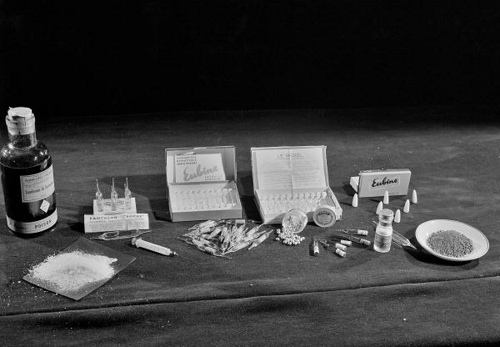Onset, duration and intensity of effect of drug depends on the rate of absorption, distribution and elimination (biotransformation, excretion). In case of oral route, plasma concentration gradually rises and reaches its peak value, then it begins to fall down. Drug requires a minimum effective plasma concentration for the effects to start appearing. Once the level falls below the minimum effective plasma concentration, the effect is over.
“Time required for the concentration of a drug to fall to half of its initial concentration after reaching its peak.”
For example, after intravenous administration, if maximum concentration is 16 mg and the half life is 2 hours, after 2 hours 8 mg will be left, and so on.
Photo by United Nations Photo
Half life of a drug is directly proportional to the volume of the distribution and inversely proportional to the clearance.
Half life = 0.693 x Vd/ total body clearance
Alpha half life = plasma / distribution half life
Beta half life = tissue / elimination half life
Most of the drugs have alpha half life and remain in the plasma. Drugs having beta half life have two half lives, one in the plasma and one in the tissues. They are highly distributed drugs. Their total time of elimination is more.
When the drug is absorbed and reaches the plasma, it is distributed to the tissues. Some drugs have high volume of distribution and are distributed to various tissues, mostly adipose tissue. More time is required for their elimination, thus have greater half life. More the clearance of a drug, shorter is the half life.
Thiopentone sodium us used as a general anesthetic. It is administered through intravenous route and has very short duration of action (about 5 to 10 min). After administration, the drug immediately goes to the brain, produces its effects, then leaves plasma to get deposited in the tissues. It is slowly released from here. Once it leaves the brain, person regains consciousness but because it is deposited in the tissues, person keeps on feeling drowsy. Elimination half life is about 7 to 10 hours. Alpha half life is about 2 to 5 minutes.
Plasma half life of some drugs:
| Drug | Half Life |
| Acetylcholine, GABA, catecholamines | Milliseconds
|
| Adenosine | 10 seconds
|
| Aspirin | 15 minutes
|
| Propanolol | 4 hours
|
| Digoxin
|
39 hours |
| Digitoxin
|
168 hours
|
| Amiodarone | more than 100 days |
Factors affecting Half Life:
1. Plasma protein binding:
Protein bound drug produces no effect and is not excreted because proteins are not filtered by glomeruli. It is thus slowly released. Drugs having plasma protein binding have longer half life ( directly proportional). Acidic drugs bind albumin while basic drugs mostly bind globulins.
Example includes warfarin, an anticoagulant, having very long half life due to extensive protein binding.
The bound drug:
- Is not distributed to tissues (stays in plasma)
- Has no pharmacological activity
- Is not metabolized (no biotransformation)
2. Pharmacokinetic pattern
The rate of absorption, metabolism, biotransformation and excretion are considered in pharmacokinetic pattern. Most important pattern is the pattern of elimination of drug, consisting of:
- Biotransformation
- Excretion
Pharmacokinetic pattern of drug elimination can be divided into:
First order kinetics:
In first order kinetics, fixed fraction of drug is eliminated in unit time. If plasma concentration of a drug is 100 mg and fixed fraction is 10%, after first hour 10 mg will be eliminated, after second hour 9 mg will be eliminated, and so on.
Zero order kinetics
In zero order kinetics, fixed amount is excreted in unit time. If plasma concentration of a drug is 100 mg and fixed amount is 10 mg, after first hour 10 mg will be eliminated, after second hour 10 mg, and so on. The capacity of body to eliminate drug is saturable, so also called saturation kinetics.
Elimination is proportional to plasma concentration in first order kinetics, but not in zero order kinetics. Half life is achieved early in zero order kinetics. Half life of drugs following first order kinetics is not affected by dose of the drug, which is not the case with zero order kinetics.
Most of the drugs follow the first order kinetics in therapeutic doses. When the dose is increased, ultimately a point is reached where systems of metabolisms become saturated, then only a fixed amount of the drug is excreted in unit time.
Significance:
Drugs which follow the first order kinetics have a constant half life. Drugs following zero order kinetics do not have a constant half life. Their increased dose increases plasma concentration which increases half life.
In toxic doses, drugs follow the zero order kinetics. Certain drugs follow zero order kinetics in therapeutics after a small increase in dose. These include:
- Alcohol
- Phenytoin
- Salicylates
Doctor needs to be extra careful with these drugs and monitor their plasma levels. Alcohol stays in blood because of zero order kinetics. Thus a dose of alcohol taken at night is still present in the blood in the morning.
3. Renal/hepatic diseases
Half life is increased in kidney diseases because the elimination is less. Half life is also increased in hepatic diseases because the metabolism is not taking place. Aminoglycosides get accumulated in renal diseases as they are excreted through glomerular filtration.
4. Active metabolites:
Some of the drugs when taken need to be converted to active metabolites. Thus they have longer half life. Example includes diazepam, which is a sedative hypnotic. It has 72 hours long half life. Aspirin has a half life of 15 minutes but salicylic acid has half life of 2 hours.
5. Enterohepatic circulation
Some drugs are metabolized in the liver. They are conjugated with glucuronic acid and excreted into the bile. In the intestines, the conjugate is broken down by the bacteria and enzymes. The active drug is released and is reabsorbed. These drugs have a longer half life. Examples include rifampicin, doxycycline, spironolactone and digitoxin.
Oral contraceptives undergo enterohepatic circulation, thus their dose must be adjusted. When interference with the enterohepatic circulation occurs (gastritis or diarrhea), decreased reabsorption and decreased half life is observed leading to therapeutic failure.
6. Volume of Distribution
Greater the volume of distribution, more is the half life.
Clinical Significance:
1. Rate of elimination
Rate of elimination is the rate at which drug is eliminated from the body. Certain minimum plasma levels of a drug have to be maintained for the effect to occur. Drugs having shorter half lives are given in frequent doses. Drugs which are eliminated slowly, are given with less frequency. About 90-95% of the drug is eliminated after four half lives.
2. Duration of Action
Drugs having longer half life have more duration of action and vice versa. Ranitidine has a half life of only 2 hours, but duration of action is about 12 hours. Although its concentration falls in the plasma but binding to site of action is tight.
3. Interval between doses
Drugs having short half life, the interval between the doses is kept short and are given frequently to maintain minimum effective plasma levels.
4. Time for steady state
When the drug is given by constant intravenous infusion or given repeatedly in fixed doses at fixed intervals, plasma concentration of drug rises gradually, and if patient is still taking the drug at fixed intervals and doses, it reaches a peak value and then plateau is reached.
This is because the amount of drug being administered is equal to the amount of the drug being eliminated, which is called the steady state.
The amount of the dug in plasma becomes constant. This can only be reached when fixed doses of drugs are given after regular intervals. At steady state,
elimination kinetics = assimilation kinetics.
After about five plasma half lives the steady state is achieved. Drugs having longer half lives take longer time to reach the steady state. Drugs having longer half lives have no immediate effect.
For the drugs which need to be monitored, first sample is taken after the steady state has been reached.
Lithium for bipolar disorder is an example. Plasma levels are maintained by repeated examinations because the drug can be toxic. Its half life is about 24 hours, so the plasma levels are checked after 5 days.
5. Time for complete elimination
Drugs having short half lives have shorter time for complete elimination. 90-95% of the drug is eliminated after four half lives.
Clinical Situations involving Increased Half Life
- Decreased renal plasma flow, e.g. heart failure, cardiogenic shock, hemorrhage.
- Increased volume of distribution
- Decreased excretion ratio as in renal diseases
- Decreased metabolism e.g. cirrhosis of liver.
Drugs having half life less than two hours:
Aspirin, ACTH, cephalosporins, chlorthiazide, heparin, lignocaine, methyl dopa, naloxone, penicillin G (30min), dobutamine (I min), esmolol
Drugs having half life between two to five hours
Atropine, cimetidine, indomethacin, paracetamol
Drugs having half life between ten to twenty four hours
Amitriptyline, imipramine, practolol, theophylline
Drugs having half life greater than thirty six hours
Diazepam, digoxin, phenobarbitone, thyroxin, warfarin, piroxicam (48 hrs).
 howMed Know Yourself
howMed Know Yourself






This article gives us the focal point of the subject.
It is good to learn
What is 0.693 in the formula of half life???
0.693 is the decay constant.
0.693 = ln(2)
The formula for half life of a first order kinetics reaction is [ln(2)/k].
I so appreciate you too much for your sending your website at a mean time ,but we have there is shortage of Computers in our Campus so ,PLEASE,PLEASE PLEASE… IF YOU VOLUNTARY I WANTS AS YOU SEND THAT ADVANCED BOOK BY P.O.BOX:307,COUNTRY :ETHIOPIA,CITY JIMMA UNIVERSITY, NAME:TOLERA FUFA FEYISSA.